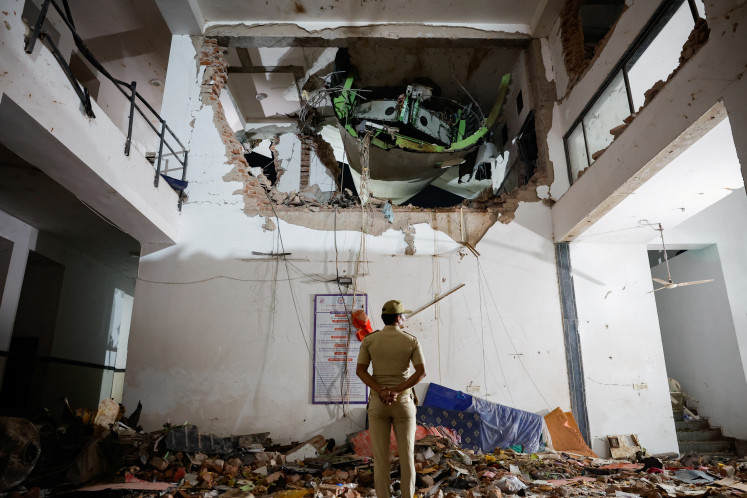How Sunda Wiwitan survives injustice
Future in their hands: Boys clad in traditional Sundanese attire attend a Sunda Wiwitan religious ceremony
Change text size
Gift Premium Articles
to Anyone

Future in their hands: Boys clad in traditional Sundanese attire attend a Sunda Wiwitan religious ceremony. (JP)
Followers of Sunda Wiwitan, one of the countless indigenous faiths in Indonesia, have survived colonial oppression and purges of non-official religions by the authoritarian New Order regime. The Jakarta Post writer Corry Elyda takes a look at how the small communities scattered across West Java and Banten provinces have stood the test of time.
Braving a night drizzle and chill, people from all walks of life flocked to Paseban Tri Panca Tunggal, an iconic cultural center of Kuningan, a hilly West Java town 245 kilometers east of Jakarta, for the ritual sacrifice of a cow.
After a while, the congregation proceeded to the iconic complex’s main building. Women were dressed in kebaya (traditional blouses) and batik while the men were clad in black uniforms and sporting the distinctive Sundanese hat.
That night’s main event was a mass service and sermon delivered by Prince Djatikusuma, the supreme leader of Akur Sunda Wiwitan Cigugur — the main sect of the Sunda Wiwitan named after the Kuningan enclave — a local faith that retains a small but loyal following across West Java and Banten.
The whole ritual was a prelude to a series of intricate events celebrating the 185th birthday of Gebang Prince Sadewa Alibassa Koesoemo Widjaja Ningrat (1832-1939). Popularly called Madrais, the prince not only reformed but also propagated Sunda Wiwitan, which is said to be as old as the country’s second-largest ethnic group. Raised in a Muslim royal family as Muhammad Rais, the prince blended the Sunda Wiwitan with other religious faiths into a new one called Agama Djawa Sunda that had subsequently been refined and renamed by his successors to survive government repressions.
In the Sundanese language, wiwitan means original or beginning. In ancient times, the land making up present-day West Java and Banten was known as the “Land of Sunda”.
For outsiders, the ceremony looked like a routine cultural event. Devout Muslims regard Sunda Wiwitan as heretical but believers embrace it as a religion and a way of life that already existed long before the advent of “mainstream” Islam and Christianity to the archipelago.
Being the local Sunda Wiwitan monastery since the 1830s, the Paseban Tri Panca Tunggal building was preserved as a National Cultural Heritage site in 1976. Now, its future is uncertain after Supreme Court in Jakarta ruled in favor of a descendant of Madrais who lays claim to the Sunda Wiwitan’s communal land as his personal property and wants to rebuild it as an eatery.
Akur Sunda Wiwitan is one of the spiritual movements practiced by the Sundanese. In the region, there are other less well-known native faiths such as Kanekes or Sunda Buhun. Sunda Wiwitan along with several other indigenous faiths from other regions came into the spotlight thanks to their years of tireless struggle to get state recognition, which succeeded last year.
Like other local religious beliefs, their teaching is centered on nature. They believe in Sang Hyang Tunggal (the oneness of God), also called Sang Hyang Karsa (the Most Powerful). Believers are taught to have the utmost respect for fellow human beings and nature. Stealing, drinking, killing and lying are strictly taboo.
“Any misdeeds that can spoil humanity are prohibited,” Dewi Kanti Setianingsih, a faith freedom activist and grand- granddaughter of Madrais, said.
Their best-known ritual is probably the annual harvest revelry Seren Taun, which captivates locals and avid cultural avocados from other regions alike. Adherents meditate twice a day facing fire or stove, at dawn and dusk.
Fire or light symbolizes enlightenment. “Fire is the medium for us to pray to God,” said Dewi, who is daughter of Djatikusuma.
Some misunderstand the use of fire in the ritual, thinking that Sunda Wiwitan followers worship fire. Dewi, who prefers to call her community the Karuhun community, says that it is just like Muslims who encircle the Kabah during the haj pilgrimage; it does not mean that they worship the stone.
Although the belief system is as old as the Sundanese ethnicity, the adherents remain subject to discrimination as described by Rian Sutarman, a 25-year-old resident of Ciamis.
“I had no friends in my first year in junior high school although I behaved well. They thought my religion was heretical,” he said. Things eventually changed for the better although people would still frown whenever they heard his religion uttered.
Despite such discrimination, Rian has refused to covert to another religion. “This is my and my family’s way of life. I do not want to change religion.”
Incredible figures
There is no official number of Sunda Wiwitan followers in Indonesia. According to Dewi, at least 400 families identify themselves as adherents in Kuningan but she has sketchy information about those who live in other regions across West Java and Banten.
The Cigugur Population and Civil Registry Agency has recorded 447 people who embrace various local faiths, 94 of them being Sunda Wiwitan.
When the state still refused to recognize local faiths, the agency duly registered their believers but left the religion space in their ID cards empty.
To avoid complications, they would randomly choose one of the six official religions: Islam, Protestantism, Catholicism, Buddhism, Hinduism and Confucianism. Interestingly, Sunda Wiwitan and other local belief systems remain unknown among the Muslim majority.
Padjajaran University historian Widyo Nugrahanto said the propagation of Sunda Wiwitan as a spiritual movement was started by Madrais following a revelation.
Widyo, who has traced back Sunda Wiwitan history as far as the Netherlands, says the number of Sunda Wiwitan followers amounted to 10,000 in the 1940s.
“It was a huge number then given that the archipelago’s population was still around 70 million. Therefore, the Dutch and Japanese colonial administrations considered it a threat,” he said.
As propagators of the faith, Madrais and his descendants avoided confrontations with the colonialists but they instilled nationalism in their followers instead.
“They believe in motherland, meaning that they believe in the land on which human beings live. It’s akin to nationalism in religious terms,” he said.
Survival tactics
Sunda Wiwitan as a community and spiritual movement has been subjected to oppression since colonial times. Suspicious that Madrais entrenched nationalism in his followers, the Dutch exiled him to Papua and sent him to a sanatorium in Bogor. The Japanese banned local spiritual movements to win the hearts and minds of Muslims they needed to help them on the frontlines.
After his death in 1939, Madrais was succeeded by one of his sons, Tedjabuana Alibasa Kusuma Widjaja Ningrat.
During the military purge of communists following the aborted coup of 1965, many adherents of indigenous faiths were accused of being communist and killed. But Sunda Wiwitan followers survived the massacre because Tedjabuana and his followers had converted to Catholicism in 1964, fulfilling the prophecy of his father about the tragedy that claimed hundreds of thousands of lives across Indonesia. They reconverted to Sunda Wiwitan when order was eventually restored.
“When he [Tedjabuana] converted to Catholicism, most Cigugur residents followed his step and when the massacre happened in 1965, they were spared,” Widyo said. And the success was replicated by numerous native faith followers in Central Java and East Java.
Traces of the conversion en masse are still visible today with the presence of Catholic churches in the predominantly Muslim Kuningan. Dewi Kanti acknowledged only the exceptional few would risk their civil rights sticking to indigenous religions like Sunda Wiwitan.
According to Widyo, Catholicism became a popular choice because Tedjabuana had good relations with Catholic politicians and his doctor was a Catholic.
The Soeharto regime did not recognize native faiths, believing that only mainstream religions would serve as the most effective means of stopping communism. Citizens who refused to convert to one of the official religions could be labeled as communists. At the height of the 1965–1966 purges, they were subject to arbitrary killing by the state security apparatus and vigilantes.
During the Soeharto regime, Sunda Wiwitan rituals were banned and followers put up no resistance to show the peace-loving nature of their religion.
In 1980s, Sunda Wiwitan believers were officially banned from holding Seren Taun, an annual rice harvest ceremony to pay respect to Nyi Pohaci Sanghyang Asri, the rice goddess. In the ritual, farmers took home their harvest and pounded the grains in mortars while singing.
“Because we were not allowed to pound rice grains and sing, we did the ritual by manually peeling the grains,” Dewi said. The celebration was revived in 2006, eight years after Soeharto’s downfall, and now it has become an annual cultural event in Kuningan.
Sunda Wiwitan followers do not propagate by coercion of any sort and give their children the freedom to embrace any religion of their choice.
Mimi Sudarmi, a 57-year-old grandmother from Garut, said her family had been practicing Sunda Wiwitan for a generation but her family was fine with her daughter converting after marrying a Catholic.
Another believer, 35-year-old Ugan Suganda, married a Muslim girl. “My in-laws asked me to convert to Islam for easy access to a civil service but I chose to stick to my [Sunda Wiwitan] religion and my wife remains a Muslim.”
Last year, the Constitutional Court in Jakarta made history when it ruled that the state should recognize indigenous religions like Sunda Wiwitan and that followers should regain their civil rights. If properly enforced, the ruling, which is disputed by conservative Muslim groups, could be a new dawn for the followers who have long been stigmatized and deprived of their basic rights.









